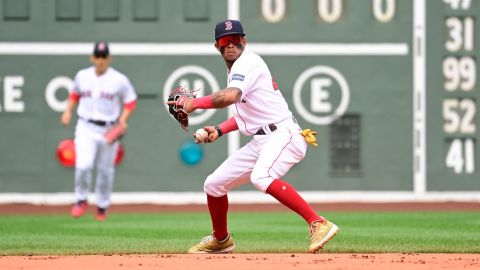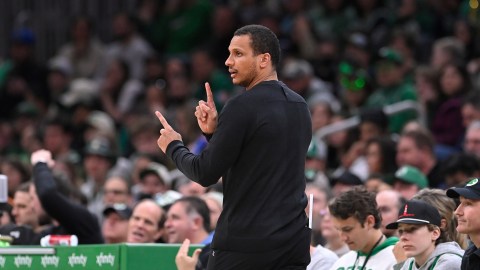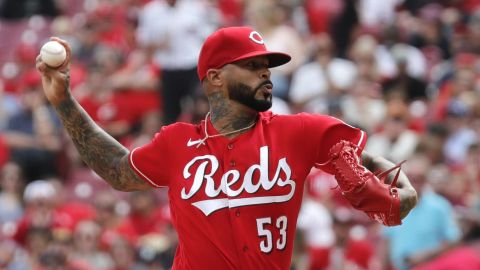This week has been all about value for the Boston Red Sox.
The Red Sox reportedly acquired pitcher Rick Porcello from the Detroit Tigers on Thursday in exchange for outfielder Yoenis Cespedes, pitcher Alex Wilson and a lower-level minor leaguer. The trade is the Red Sox’s second in two days — they reportedly landed pitcher Wade Miley from the Arizona Diamondbacks on Wednesday — and it’s clear Boston is placing an emphasis on obtaining innings-eating, ground-ball pitchers with upside.
There’s nothing sexy about the Red Sox’s rotation, as constituted, after landing Porcello. Porcello, Miley, Clay Buchholz, Joe Kelly and Justin Masterson all look like middle- to back-of-the-rotation starters, leaving Boston with an uninspiring situation, especially in the wake of losing out to the Chicago Cubs in the Jon Lester sweepstakes. But it’s important to note the Red Sox still have the flexibility — both financially and talent-wise — to land a top-flight pitcher capable of anchoring a unit that’s in far better shape now than it was at the beginning of the Major League Baseball winter meetings, if Boston so chooses.
The moans and groans among Red Sox fans are loud, as mid-rotation starters seemingly have replaced outfielders as the flavor of the month. On their own, however, the Miley and Porcello trades make sense. Boston has acquired two talented hurlers with favorable contracts whose skill sets fit Fenway Park. In the process, the Red Sox relinquished players who were a dime a dozen as far as their roster is concerned.
Make no mistake, Cespedes has top-notch power, which is at a premium these days. He’ll instantly improve a Tigers offense that’s already potent. But the Red Sox need more than “tools” at this point. They need arms capable of providing meaningful innings. Cespedes’ defensive deficiencies, his poor on-base ability and the Red Sox’s surplus of outfielders made the Cuban slugger expendable amid Boston’s quest for pitching. Likewise, Rubby De La Rosa and Allen Webster — the players reportedly surrendered for Miley — were plucked from a crowded source of talent within the Red Sox organization.
So, why Porcello?
Well, the right-hander is coming off the best season of his six-year career. He went 15-13 with a 3.43 ERA and 1.23 WHIP in 32 games (31 starts) spanning 204 2/3 innings. His career strikeout rate (5.5 strikeouts per nine innings) is nothing to write home about, but his pinpoint control (2.2 walks per nine innings) and his worm killing tendencies (52.1 percent ground ball rate) look delicious in the context of pitching at Fenway Park.
Porcello is turning only 26 this month. The former first-round pick is eligible for free agency next offseason, but the Red Sox aren’t required to make a sizable financial commitment at this time. The team can see how Porcello adjusts to Boston, and then potentially lock up a pitcher in his prime years.
The Red Sox also stand to benefit from the trade even if Porcello leaves in free agency next winter, as the club could extend a qualifying offer and recoup a draft pick — potentially a first-rounder — if he signs elsewhere. The Sox would not have been unable to obtain a draft pick in exchange for losing Cespedes due to a provision in the outfielder’s contract. That was a troubling reality given that Cespedes seemed like a strong candidate to walk.
Do the Red Sox need an “ace”? It obviously wouldn’t hurt. The Red Sox’s offense figures to be much improved, though, and that could help offset some of the team’s other shortcomings, unless those shortcomings include infield defense, which will be paramount this season with so many ground ball pitchers in tow.
The Baltimore Orioles won 96 games and the American League East last season with a rotation that featured some combination of Chris Tillman, Wei-Yin Chen, Bud Norris, Miguel Gonzalez, Ubaldo Jimenez and Kevin Gausman. It’s not impossible for the Red Sox to follow a similar path and thrive in the absence of a true “ace,” provided the current staff pitches up to its potential.
Boston’s rotation probably isn’t a finished product, and it isn’t a jaw-dropping unit, by any means. But at least the Red Sox finally look like they have a game plan rather than flying by the seat of their pants.
The plan involves leveraging their strengths to address their biggest flaw. Can’t fault them for that.
Thumbnail photo via Mark J. Rebilas/USA TODAY Sports Images




